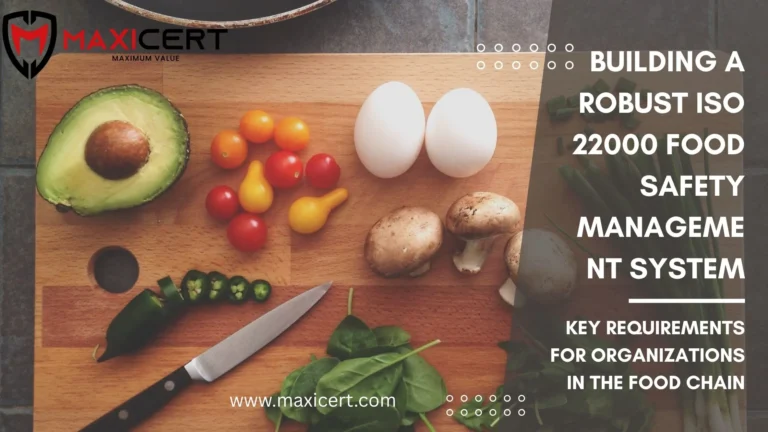Building a Robust ISO 22000 Food Safety Management System: Key Requirements for Organizations in the Food Chain

Introduction
Food safety is a critical concern for every organization involved in the food chain, from production to consumption. A well-structured Food Safety Management System (FSMS) based on ISO 22000 is crucial for ensuring ISO certification, protecting consumers, and maintaining trust in your brand. Whether you’re a manufacturer, processor, or distributor, implementing an FSMS helps identify, evaluate, and control food safety hazards while meeting regulatory and customer requirements.
In this blog, we explore the core requirements of an effective FSMS, including documentation, management responsibilities, communication strategies, and emergency preparedness. Discover how to build a system that not only safeguards your products but also strengthens your reputation in the food industry. If you’re looking for the best consultant to guide you through the ISO 22000 certification process, Maxicert offers expert support and proven solutions to help you succeed.
Food Safety Management System
1.1 General requirements:
The organization shall establish, document, implement and maintain an effective food safety management system and update it, when necessary, in accordance with the requirements of this International Standard. The organization shall define the scope of the food safety management system. The scope shall specify the products or product categories, processes and production sites that are addressed by the food safety management system.
Request A Free Quote
The organization shall
- Ensure that food safety hazards that may be reasonably expected to occur in relation to products within the scope of the system are identified, evaluated and controlled in such a manner that the products of the organization do not, directly or indirectly, harm the consumer.
- Communicate appropriate information throughout the food chain regarding safety issues related to its products.
- Communicate information concerning development, implementation and updating of the food safety management system throughout the organization, to the extent necessary to ensure the food safety required by this International Standard.
- Evaluate periodically and update, when necessary, the food safety management system to ensure that the system reflects the organization’s activities and incorporates the most recent information on the food safety hazards subject to control.
Where an organization chooses to outsource any process that may affect end product conformity, the organization shall ensure control over such processes. Control of such outsourced processes shall be identified and documented within the food safety management system.
1.2 Documentation requirements
1.2.1 General:
The food safety management system documentation shall include
- Documented statements of a food safety policy and related objectives.
- Documented procedures and records required by this International Standard.
- Documents needed by the organization to ensure the effective development, implementation and updating of the food safety management system.
1.2.2 Control of documents
Documents required by the food safety management system shall be controlled. Records are a special type of document and shall be controlled according to the requirements given in 4.2.3. The controls shall ensure that all proposed changes are reviewed prior to implementation to determine their effects on food safety and their impact on the food safety management system. A documented procedure shall be established to define the controls needed.
- To approve documents for adequacy prior to issue.
- To review and update documents as necessary, and re-approve documents.
- To ensure that changes and the current revision status of documents are identified.
- To ensure that relevant versions of applicable documents are available at points of use.
- To ensure that documents remain legible and readily identifiable.
- To ensure that relevant documents of external origin are identified and their distribution controlled.
- To prevent the unintended use of obsolete documents, and to ensure that they are suitably identified as such if they are retained for any purpose.
1.2.3 Control of records
Records shall be established and maintained to provide evidence of conformity to requirements and evidence of the effective operation of the food safety management system. Records shall remain legible, readily identifiable and retrievable. A documented procedure shall be established to define the controls needed for the identification, storage, protection, retrieval, retention time and disposition of records.
2 Management responsibility
2.1 Management commitment
Top management shall provide evidence of its commitment to the development and implementation of the food safety management system and to continually improving its effectiveness by
- Showing that food safety is supported by the business objectives of the organisation.
- Communicating to the organisation the importance of meeting the requirements of this International Standard, any statutory and regulatory requirements, as well as customer requirements relating to food safety.
- Establishing the food safety policy.
- Conducting management reviews.
- Ensuring the availability of resources.
2.2 Food Safety Policy
Top management shall define, document and communicate its food safety policy. Top management shall ensure that the food safety policy
- Is appropriate to the role of the organization in the food chain.
- Conforms with both statutory and regulatory requirements and with mutually agreed food safety requirements of customers.
- Is communicated, implemented and maintained at all levels of the organization.
- Is reviewed for continued suitability.
- Adequately addresses communication.
- Is supported by objectives.
2.3 Food Safety Management System Planning
Top management shall ensure that
- Planning of the food safety management system is carried out to meet requirements as well as the objectives of the organization that support food safety.
- The integrity of the food safety management system is maintained when changes to the food safety management system are planned and implemented.
2.4 Responsibility and Authority
Top management shall ensure that responsibilities and authorities are defined and communicated within the organization to ensure the effective operation and maintenance of the food safety management system. All personnel shall have responsibility to report problems with the food safety management system to identified person(s). Designated personnel shall have defined responsibility and authority to initiate and record actions.
2.5 Food Safety Team Leader
Top management shall appoint a food safety team leader who, irrespective of other responsibilities, shall have the responsibility and authority
- To manage a food safety team and organize its work.
- To ensure relevant training and education of the food safety team members.
- To ensure the food safety management system is established, implemented, maintained and updated.
- To report to the organisation’s top management on the effectiveness and suitability of the food safety management system.
NOTE: The responsibility of the food safety team leader may include liaison with external parties on matters relating to the food safety management system,
2.6 Communication
2.6.1 External communication
To ensure sufficient information on issues concerning food safety is available throughout the food chain, the organization shall establish, implement and maintain effective arrangements for communicating with
- Suppliers and contractors.
- Customers or consumers, in particular in relation to product information (including instructions regarding intended use, specific storage requirements and, as appropriate, shelf life), enquiries, contracts or order handling including amendments, and customer feedback including customer complaints.
- Statutory and regulatory authorities.
- Other organizations that have an impact on, or will be affected by, the effectiveness or updating of the food safety management system.
Such communication shall provide information on food safety aspects of the organization’s products that may be relevant to other organizations in the food chain. This applies especially to known food safety hazards that need to be controlled by other organizations in the food chain. Records of communications shall be maintained.
Food safety requirements from statutory and regulatory authorities and customers shall be available. Designated shall have defined responsibility and authority to communicate externally any concerning food safety. Information obtained through external communication shall be included as input to system and management review.
2.6.2 Internal Communication
The organization shall establish, implement and maintain effective arrangements for communicating with personnel on issues having an impact on food safety. In order to maintain the effectiveness of the food safety management system, the organization shall ensure that the food safety team is informed in a timely manner of changes, including but not limited to the following:
- Products or new products.
- Raw materials, ingredients and services.
- Production and equipment.
- Production premises, location of equipment, surrounding environment.
- Cleaning and sanitation programmes.
- Packaging, storage and distribution systems.
- Personnel qualification levels and/or allocation of responsibilities and authorizations.
- Statutory and regulatory requirements.
- Knowledge regarding food safety hazards and control measures.
- Customer, sector and other requirements that the organization observes
- Relevant enquiries from external interested parties
- Complaints indicating food safety hazards associated with the product.
- Other conditions that have an impact on food safety.
The food safety team shall ensure that this information is included in the updating of the food safety management system. Top management shall ensure that relevant information is included as input to the management review.
2.7 Emergency Preparedness and Response
Top management shall establish, implement and maintain procedures to manage potential emergency situations and accidents that can impact food safety and which are relevant to the role of the organization in the food chain.
2.8 Management review
2.8.1 General
Top management shall review the organization’s food safety management system at planned intervals to ensure its continuing suitability, adequacy and effectiveness. This review shall include assessing opportunities for improvement and the need for change to the food safety management system, including the food safety policy. Records of management reviews shall be maintained.
2.8.2 Review input
The input to management review shall include, but is not limited to, information on
- Follow-up actions from previous management reviews.
- Analysis of results of verification activities.
- Changing circumstances that can affect food safety.
- Emergency situations, accidents and withdrawals.
- Reviewing results of system-updating activities.
- Review of communication activities, including customer feed-back.
- External audits or inspections.
NOTE: The term “withdrawal” includes recall.
The data shall be presented in a manner that enables top management to relate the information to stated objectives of the food safety management system.
2.8.3 Review Output
The output from the management review shall include decisions and actions related to
- Assurance of food safety.
- Improvement of the effectiveness of the food safety management system.
- Resource needs.
- Revisions of the organization’s food safety policy and related objectives.
Conclusion
Implementing a robust Food Safety Management System (FSMS) ensures compliance with international standards like ISO 22000, enhances consumer trust, and minimizes risks associated with food safety hazards. Regular evaluation, effective communication, and top management commitment are essential for maintaining food safety across the supply chain.
If you’re ready to strengthen your food safety practices and achieve ISO certification, Maxicert is here to help. As a best consultant for ISO standards, we provide expert guidance and end-to-end support to help your organization implement and maintain a strong FSMS. Visit Maxicert to start your certification journey with confidence.

Get In Touch

Get In Touch

Get In Touch
FAQ
What is a Food Safety Management System (FSMS)?
A Food Safety Management System (FSMS) is a structured framework that helps organizations identify, control, and manage food safety hazards to ensure compliance with regulatory and international standards like ISO 22000.
Why is ISO 22000 certification important for my business?
ISO 22000 certification ensures food safety, enhances consumer trust, improves regulatory compliance, and strengthens your market reputation by demonstrating commitment to high food safety standards.
How can my organization get ISO 22000 certified?
To get ISO 22000 certified, your organization must implement an FSMS, conduct internal audits, and undergo a certification audit by an accredited body. PopularCert can guide you through the entire certification process. Contact us today!



